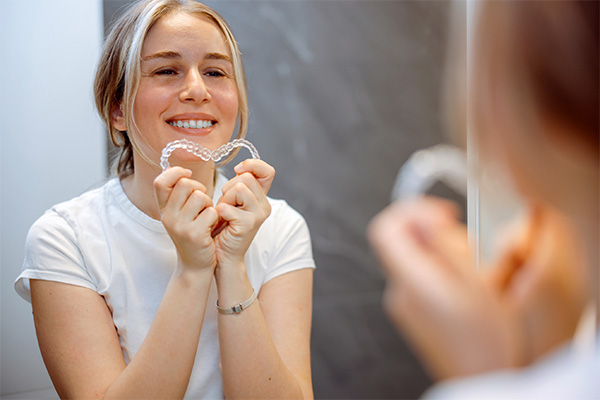For a long time, Braces were once the only option for people looking to straighten their teeth. With wires and brackets, they were a commitment that required regular adjustments from an orthodontist. However, the advent of Invisalign® and 3M™ Clarity™ Aligners revolutionized the field of orthodontics, offering patients a more discreet and comfortable alternative to traditional braces.
For a much better understanding, you should know that Invisalign® and 3M™ Clarity™ Aligners are the two most popular brands of clear aligners on the market. While Invisalign® and 3M™ Clarity™ Aligners share many similarities, they also have key differences. The best option for you will depend on your individual needs and preferences. Find out which one best suits your desired needs by reading this comprehensive guide.
Company Overview:
Invisalign®
Invisalign® is a global leader in clear aligner technology, offering a revolutionary alternative to traditional metal braces. Founded in 1997, Invisalign® has been at the forefront of orthodontic advancements, providing patients with a discreet and comfortable way to straighten their teeth.

Invisalign® uses a series of custom-made, clear aligners that gradually shift teeth into their desired positions. These aligners are virtually invisible, making them a popular choice for adults and teenagers who want to improve their smiles without the aesthetic concerns associated with traditional braces.
3M™ Clarity™ Aligners
3M entered the clear aligner market in 2018 with Clarity Clear Braces. They later expanded their offerings to include clear aligners and have since made significant improvements to their product, including the introduction of a new type of plastic and a refined treatment planning process.

They are a leading brand of clear orthodontic treatment designed to straighten teeth without the visible appearance of traditional metal braces. Backed by the innovation and reliability of 3M, Clarity Aligners offer a discreet and effective solution for individuals seeking a more aesthetic approach to orthodontic care.
Their commitment to quality and patient satisfaction is evident in the design and development of 3M Clarity Aligners. These aligners are custom-made to fit each patient’s unique dental structure, ensuring a comfortable and effective treatment experience. The clear material of 3M Clarity Aligners makes them virtually invisible, allowing patients to maintain their desired appearance throughout the treatment process.
Scope – What Conditions Do They Treat?
Invisalign® and 3M Clarity Aligners are both effective orthodontic treatments capable of addressing a variety of dental issues. Let’s explore the specific conditions they can treat:
Invisalign® Treatment Scope
- Malocclusion Types: Invisalign® can treat all classes of malocclusions, from mild to severe. Their aligners have demonstrated success in treating Class I, II, and III malocclusions. This includes overbites, underbites, crossbites, and open bites.
- Tooth Movement: Both molars and front teeth can be moved effectively with Invisalign®, ensuring a comprehensive realignment.
- Variety of Cases: Invisalign® is suitable for a wide range of dental issues, including crowding, gaps, and bite problems.
3M™ Clarity™ Aligners Treatment Scope
- Malocclusion Types: Clarity Aligners can effectively address all classes of malocclusions, including complex cases with skeletal components, such as crowded teeth, Gapped teeth, Overbite, Underbite , Crossbite, Open bite, Snaggletooth, and Midline misalignment.
- Tooth Movement: These aligners are capable of moving all teeth, including molars, to achieve comprehensive alignment.
- Customization: Clarity Aligners offer a range of customization options to tailor the treatment plan to individual needs.
While both Invisalign® and 3M Clarity Aligners can treat a similar range of orthodontic conditions, their approach has subtle differences. Clarity Aligners may offer slightly more nuanced tooth movements due to their use of attachments. These attachments are lower profile and can be placed on the backs of teeth, allowing for more precise force application.
This flexibility in attachment placement can be beneficial for certain cases where more intricate tooth movements are required. However, it’s important to note that both Invisalign® and Clarity Aligners are highly effective orthodontic treatments, and the best choice for you will depend on your individual needs and dental condition.
Quality of Material
While attachments can enhance the range of tooth movement for clear aligners, the primary force behind the treatment comes from the materials used. Therefore, the quality of the material plays a crucial role in the overall treatment scope.
3M™ Clarity™ Aligners
3M™ Clarity™ distinguishes itself from other providers by employing two distinct materials:
- Flex: This material is composed of five unique layers, resulting in its exceptional flexibility. It is particularly well-suited for rotation and proclination, especially when used in combination with Force.
- Force: A stiffer material, Force is ideal for expansion, torque, and raising or lowering teeth.

The orthodontist can strategically switch between Flex and Force aligners throughout treatment, tailoring the material to the specific tooth movements required at each stage.
Invisalign®
Invisalign® utilizes a proprietary plastic called SmartTrack. This material is a multilayer aromatic thermoplastic polyurethane/copolyester blend engineered to address both simple and complex tooth shifts effectively.

Key features of SmartTrack include:
- SmartTrack applies a consistent, gentle force to the teeth, ensuring predictable and controlled movements.
- This material enhances the orthodontist’s ability to guide tooth movements, leading to the desired smile outcome.
- SmartTrack is designed to be comfortable and fit snugly around the teeth, minimizing discomfort and irritation.
- The material’s properties contribute to more predictable tooth straightening, reducing treatment time.
The development of SmartTrack involved extensive research and testing, with over 260 materials evaluated. Invisalign®’s decades of expertise in biomechanics and material science were instrumental in creating this innovative material.
Design & Appearance
Clarity Aligners and Invisalign® both prioritize a discreet and aesthetically pleasing appearance. However, there are subtle differences in their design:
Clarity Aligners
- Material: Clarity Aligners are made of matte, smooth plastic that blends seamlessly with the teeth. They are also nearly invisible and more stain-resistant than Invisalign® aligners.
- Cut: Orthodontists can choose between a scalloped or straight cut, enhancing the aligner’s discreteness.
- Supplemental Attachments: While attachments can enhance tooth movement, they can also increase the visibility of clear aligners. Clarity Aligners are designed to be as low-profile as possible, and in some cases, attachments can be placed behind the teeth for even greater discretion.
- Customization: Offers customization options to tailor the treatment plan to individual needs. This can include adjusting the aligner’s design or the frequency of aligner changes.
Invisalign®
- Material: Invisalign® Aligners employ a frosted, textured plastic that closely resembles the surface of natural teeth.
- Cut: They are consistently scalloped to match the gum line, providing a more natural appearance.
- Supplemental Attachments: Supplemental appliances, such as attachments or elastics, can increase the visibility of Invisalign® aligners.
- Customization: Offers customization options to tailor the treatment plan.
Both Clarity Aligners and Invisalign® are designed to be discreet and blend in with the teeth. The choice between the two often comes down to personal preference and the individual patient’s specific needs.
Affordability Comparison
A straighter smile can significantly improve oral health, boost confidence, and even alleviate jaw pain. While these benefits are invaluable, it’s essential to consider the financial aspect of orthodontic treatment. Both 3M Clarity Aligners and Invisalign® offer exceptional value, but they also come with a price tag that exceeds that of at-home aligners and some competitors.
Orthodontic treatment costs are highly individualized, as each patient’s needs and treatment plan are unique. Clear aligners typically do not have a fixed price, as the cost can vary based on the chosen system, the number of aligners required, and additional factors such as the orthodontist’s experience, location, and office visits.
Clarity Aligners and Invisalign® generally fall within a similar price range, with most treatments costing around $5,000 or more. This places them among the more expensive clear aligner options on the market.
Many orthodontists offer financing options to make orthodontic care more accessible. At Orthodontic Experts, we accept major dental insurances that might cover a certain percentage of your clear aligners and provide additional financing arrangements. Our ongoing goal is to expand our network and services to make orthodontic care affordable and accessible for everyone.
Which One Should You Choose?
Both 3M™ Clarity™ Aligners and Invisalign® are excellent choices for orthodontic treatment. The best option for you will depend on your individual needs, preferences, and dental condition.
3M™ Clarity™ Aligners may be a good choice for those seeking significant tooth movement or complex corrections. The ability to customize the treatment plan with different materials and attachments can be advantageous.
Invisalign® may be a suitable option for those who prefer a well-established brand with a long history in orthodontic treatment. Their proprietary SmartTrack material offers predictable and controlled tooth movements.
Ultimately, the decision of which aligner to choose should be made in consultation with your orthodontist. They can assess your specific needs, recommend the most appropriate treatment, and provide personalized guidance throughout the process.
Frequently Asked Questions
How much do Clarity Aligners and Invisalign® cost?
The cost of Clarity Aligners and Invisalign® can vary depending on several factors. More complex cases may require additional aligners or adjustments, increasing the overall cost. It also depends on the Geographic location and can influence the cost of orthodontic treatment, as prices may vary between different regions. Finally, Orthodontists with more experience or specialized training may charge higher fees.
How long do Clarity Aligners and Invisalign® take?
The duration of treatment with Clarity Aligners or Invisalign® depends on the severity of your dental condition. In general, treatment can take anywhere from 6 to 18 months. However, some cases may require a shorter or longer treatment time. It depends on your particular situation
Can I wear my aligners only at night?
While some patients may be able to wear their aligners only at night, it’s generally recommended to wear them for at least 20-22 hours per day for optimal results. Wearing them consistently throughout the day will help ensure that your teeth move as intended.
What conditions can 3M™ Clarity™ Aligners and Invisalign® treat?
Both 3M™ Clarity™ Aligners and Invisalign® can treat a wide range of dental conditions; some common conditions include:
- Overbites
- Underbites
- Crossbites
- Open bites
- Crowding
- Gaps
- Misaligned teeth
Are home aligners safe?
Home aligners are generally not considered safe. They are not designed or monitored by a qualified orthodontist, and they may not provide the same level of treatment or results as professional aligners. It’s essential to consult with an orthodontist to ensure you receive the best possible care.
Does insurance cover clear aligners?
Some insurance plans may cover a portion of the cost of clear aligners, but this varies depending on your specific coverage. It’s important to check with your insurance provider to determine your eligibility and coverage limits.










